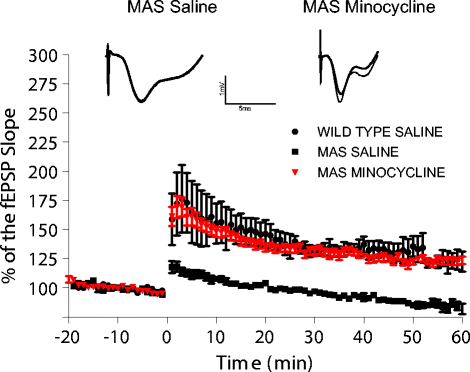An open-label pilot trial of minocycline in children as a treatment for Angelman syndrome
- PMID: 25491305
- PMCID: PMC4276108
- DOI: 10.1186/s12883-014-0232-x
An open-label pilot trial of minocycline in children as a treatment for Angelman syndrome
Abstract
Background: Minocycline, a member of the tetracycline family, has a low risk of adverse effects and an ability to improve behavioral performance in humans with cognitive disruption. We performed a single-arm open-label trial in which 25 children diagnosed with Angelman syndrome (AS) were administered minocycline to assess the safety and tolerability of minocycline in this patient population and determine the drug's effect on the cognitive and behavioral manifestations of the disorder.
Methods: Participants, age 4-12 years old, were randomly selected from a pool of previously screened children for participation in this study. Each child received 3 milligrams of minocycline per kilogram of body weight per day for 8 weeks. Participants were assessed during 3 study visits: baseline, after 8-weeks of minocycline treatment and after an 8-week wash out period. The primary outcome measure was the Bayley Scales of Infant and Toddler Development 3rd Edition (BSID-III). Secondary outcome measures included the Clinical Global Impressions Scale (CGI), Vineland Adaptive Behavior Scales 2nd Edition (VABS-II), Preschool Language Scale 4th Edition (PLS-IV) and EEG scores. Observations were considered statistically significant if p < 0.05 using ANOVA and partial eta squared (η(2)) was calculated to show effect size. Multiple comparisons testing between time points were carried out using Dunnett's post hoc testing.
Results: Significant improvement in the mean raw scores of the BSID-III subdomains communication and fine motor ability as well as the subdomains auditory comprehension and total language ability of the PLS-IV when baseline scores were compared to scores after the washout period. Further, improvements were observed in the receptive communication subdomain of the VABS-II after treatment with minocycline. Finally, mean scores of the BSID-III self-direction subdomain and CGI scale score were significantly improved both after minocycline treatment and after the wash out period.
Conclusion: The clinical and neuropsychological measures suggest minocycline was well tolerated and causes improvements in the adaptive behaviors of this sample of children with Angelman syndrome. While the optimal dosage and the effects of long-term use still need to be determined, these findings suggest further investigation into the effect minocycline has on patients with Angelman syndrome is warranted.
Trial registration: NCT01531582 - clinicaltrials.gov.
Figures

Similar articles
-
A randomized placebo controlled clinical trial to evaluate the efficacy and safety of minocycline in patients with Angelman syndrome (A-MANECE study).Orphanet J Rare Dis. 2018 Aug 20;13(1):144. doi: 10.1186/s13023-018-0891-6. Orphanet J Rare Dis. 2018. PMID: 30126448 Free PMC article. Clinical Trial.
-
A neurodevelopmental survey of Angelman syndrome with genotype-phenotype correlations.J Dev Behav Pediatr. 2010 Sep;31(7):592-601. doi: 10.1097/DBP.0b013e3181ee408e. J Dev Behav Pediatr. 2010. PMID: 20729760 Free PMC article.
-
A pilot, open-label, 8-week study evaluating the efficacy, safety and tolerability of adjunctive minocycline for the treatment of bipolar I/II depression.Bipolar Disord. 2017 May;19(3):198-213. doi: 10.1111/bdi.12496. Bipolar Disord. 2017. PMID: 28599348
-
Low glycemic index treatment for seizures in Angelman syndrome.Epilepsia. 2012 Sep;53(9):1498-502. doi: 10.1111/j.1528-1167.2012.03537.x. Epub 2012 Jul 10. Epilepsia. 2012. PMID: 22779920
-
Ability change across multiple domains in mucopolysaccharidosis (Sanfilippo syndrome) type IIIA.Mol Genet Metab. 2024 Feb;141(2):108110. doi: 10.1016/j.ymgme.2023.108110. Epub 2023 Dec 15. Mol Genet Metab. 2024. PMID: 38151384
Cited by
-
Qualitative Insights into Key Angelman Syndrome Motor Related Concepts Reported by Caregivers-A Thematic Analysis of Semi-Structured Interviews.Children (Basel). 2023 Aug 28;10(9):1462. doi: 10.3390/children10091462. Children (Basel). 2023. PMID: 37761423 Free PMC article.
-
The STARS Phase 2 Study: A Randomized Controlled Trial of Gaboxadol in Angelman Syndrome.Neurology. 2021 Feb 16;96(7):e1024-e1035. doi: 10.1212/WNL.0000000000011409. Epub 2020 Dec 21. Neurology. 2021. PMID: 33443117 Free PMC article. Clinical Trial.
-
Minocycline causes widespread cell death and increases microglial labeling in the neonatal mouse brain.Dev Neurobiol. 2017 Jun;77(6):753-766. doi: 10.1002/dneu.22457. Epub 2016 Oct 14. Dev Neurobiol. 2017. PMID: 27706925 Free PMC article.
-
A multidisciplinary approach and consensus statement to establish standards of care for Angelman syndrome.Mol Genet Genomic Med. 2022 Mar;10(3):e1843. doi: 10.1002/mgg3.1843. Epub 2022 Feb 11. Mol Genet Genomic Med. 2022. PMID: 35150089 Free PMC article. Review.
-
Using the Bayley-4 and Vineland-3 in Angelman syndrome: barriers, solutions, and challenging items.Orphanet J Rare Dis. 2025 Jun 3;20(1):273. doi: 10.1186/s13023-025-03817-x. Orphanet J Rare Dis. 2025. PMID: 40462183 Free PMC article.
References
Publication types
MeSH terms
Substances
Associated data
LinkOut - more resources
Full Text Sources
Other Literature Sources
Medical
Molecular Biology Databases
Research Materials

